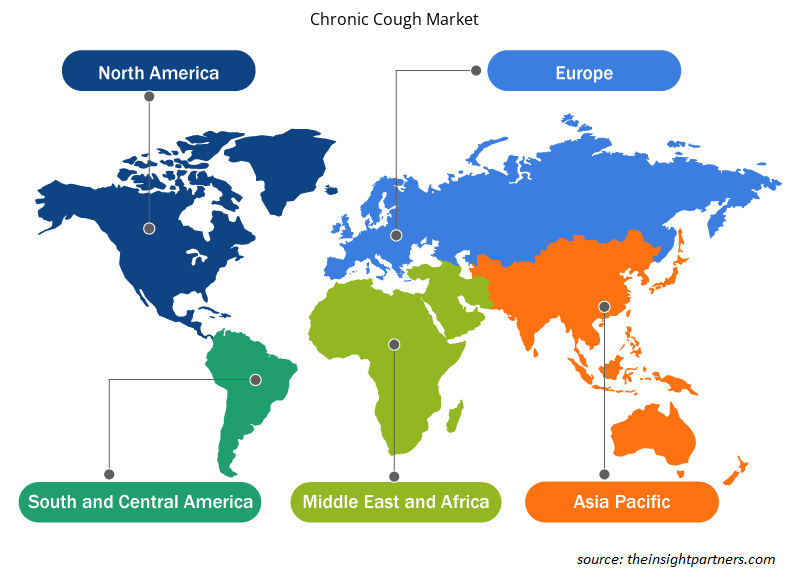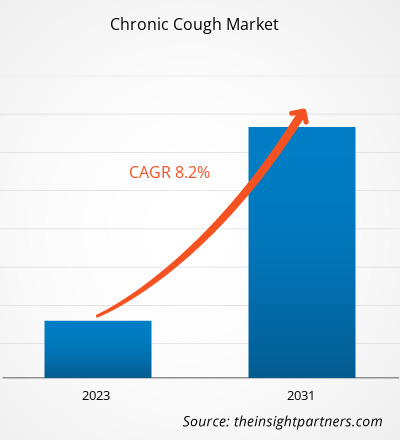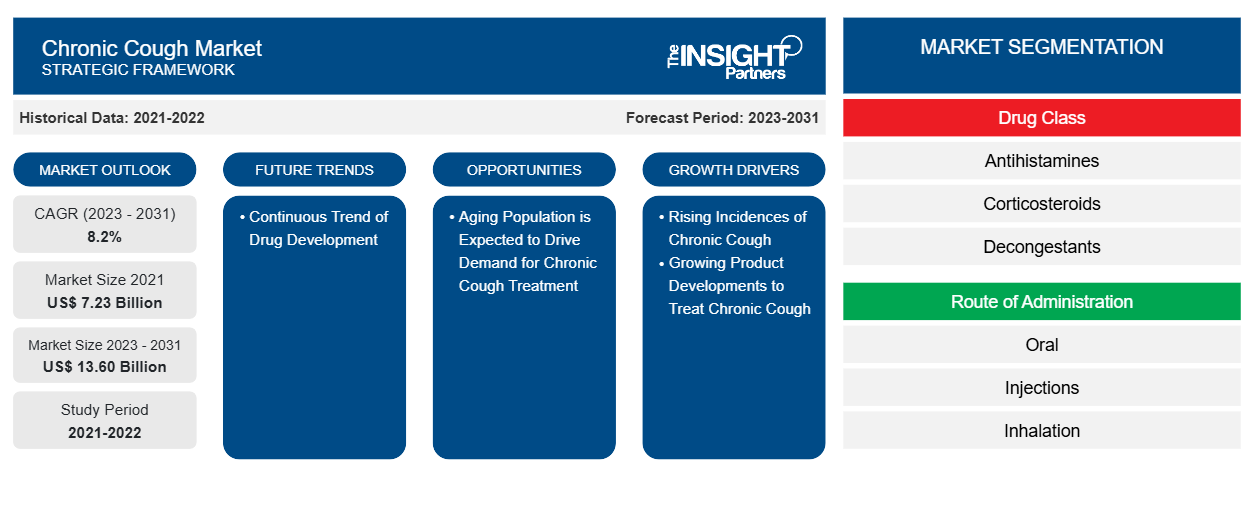Der Markt für chronischen Husten belief sich 2021 auf 7,23 Milliarden US-Dollar und soll von XX Milliarden US-Dollar im Jahr 2023 auf 13,60 Milliarden US-Dollar im Jahr 2031 anwachsen. Der Markt wird voraussichtlich zwischen 2023 und 2031 eine durchschnittliche jährliche Wachstumsrate (CAGR) von 8,2 % verzeichnen. Das steigende Bewusstsein für Atemwegsprobleme sowie Fortschritte in der medizinischen Forschung und Behandlungsoptionen und der kontinuierliche Trend zur Arzneimittelentwicklung werden voraussichtlich weiterhin die wichtigsten Markttrends für chronischen Husten bleiben.
Chronischer Husten Marktanalyse
Der globale Markt für chronischen Husten wird vor allem durch die steigende Verbreitung chronischer Lungeninfektionen angetrieben, da hartnäckiger Husten eine häufige Indikation ist, sowie durch die Entwicklung neuer Produkte zur Behandlung von chronischem Husten. Die Marktexpansion wird durch eine deutliche Veränderung hin zur Priorisierung der Atemwegsgesundheit und des Wohlbefindens sowie durch staatliche und nichtstaatliche Initiativen vorangetrieben.
Marktübersicht für chronischen Husten
Ein chronischer Husten hält acht Wochen oder länger an. Infektionen, Asthma und Magen-Darm-Reflux tragen alle zu seiner Verbreitung bei. Anzeichen und Symptome des chronischen Hustens sind unter anderem ein Gefühl von Flüssigkeit, die den Rachen hinunterläuft (Postnasal Drip) und Kopfschmerzen. Regelmäßiges Räuspern, Halsschmerzen, Heiserkeit, Kurzatmigkeit , Keuchen, saurer Geruch im Mund oder Sodbrennen. Es gab einen Anstieg der Investitionen in die Gesundheitsinfrastruktur, Diagnoseeinrichtungen und Patientenaufklärungsprogramme, um die Behandlung und Früherkennung von chronischem Husten zu verbessern.
Passen Sie diesen Bericht Ihren Anforderungen an
Sie erhalten kostenlos individuelle Anpassungen an jedem Bericht, einschließlich Teilen dieses Berichts oder einer Analyse auf Länderebene, eines Excel-Datenpakets sowie tolle Angebote und Rabatte für Start-ups und Universitäten.
- Holen Sie sich die wichtigsten Markttrends aus diesem Bericht.Dieses KOSTENLOSE Beispiel umfasst eine Datenanalyse von Markttrends bis hin zu Schätzungen und Prognosen.
Treiber und Chancen auf dem Markt für chronischen Husten
Zunehmende Verbreitung von chronischem Husten fördert Marktwachstum
Erkrankungen wie Infektionen, Lungenerkrankungen und Bronchitis führen ebenfalls häufig zu chronischem Husten. Erkrankungen wie Asthma nehmen weltweit zu und treten häufig bei Kindern und Erwachsenen auf. Laut einer im Februar 2024 veröffentlichten Studie mit dem Titel „Prävalenz von chronischem Husten, seine Risikofaktoren und das der Bevölkerung zuzuschreibende Risiko in der Burden of Obstructive Lung Disease (BOLD)-Studie: eine multinationale Querschnittsstudie“ lag die Prävalenz von chronischem Husten zwischen 2 % und 18 %. Rauchen, Asthma, chronisch obstruktive Lungenerkrankung (COPD), Fettleibigkeit, Hustensyndrom der oberen Atemwege (UACS) und gastroösophageale Refluxkrankheit (GERD) sind einige der Faktoren, die am häufigsten mit chronischem Husten in Verbindung gebracht werden.COPD), obesity, upper airway cough syndrome (UACS), and gastro-oesophageal reflux disease (GORD) are some of the factors that have most commonly been associated with chronic cough.
Die zunehmende Alterung der Bevölkerung dürfte die Nachfrage nach Behandlungsmöglichkeiten für chronischen Husten ankurbeln
Ältere Menschen sind anfälliger für chronischen Husten und das zunehmende Alter ist der Hauptfaktor für eine verminderte Immunität. Die altersbedingte Degeneration von Organen und gesundem Gewebe führt zu verschiedenen Gesundheitsproblemen. Chronischer Husten ist eines der am häufigsten auftretenden Gesundheitsprobleme bei älteren Menschen. Mit zunehmendem Alter beginnt das Atmungssystem zu degenerieren. Daher steigt bei älteren Menschen die Wahrscheinlichkeit, an Atemwegsinfektionen wie Lungenentzündung und Grippe zu erkranken.
Die alternde Bevölkerung wächst weltweit, da Industrie- und Entwicklungsländer eine sinkende Sterberate verzeichnen. Die Entwicklungen im Gesundheitswesen haben die öffentliche Gesundheit verbessert und zu einer höheren Lebenserwartung geführt. Laut WHO wird die Weltbevölkerung der über 60-Jährigen bis 2050 auf 2,1 Milliarden anwachsen. Die Zahl der über 80-Jährigen wird sich zwischen 2020 und 2050 voraussichtlich verdreifachen und 426 Millionen erreichen. Daher wird erwartet, dass die wachsende geriatrische Bevölkerung im Prognosezeitraum wahrscheinlich mehr Behandlungen für chronischen Husten benötigt.
Segmentierungsanalyse des Marktberichts über chronischen Husten
Wichtige Segmente, die zur Ableitung der Marktanalyse für chronischen Husten beigetragen haben, sind Arzneimittelklasse, Verabreichungsweg und Vertriebskanal.
- Basierend auf der Medikamentenklasse ist der Markt für chronischen Husten in Antihistaminika, Kortikosteroide, Entstauungsmittel, Kombinationspräparate, Antibiotika, Säureblocker und andere Medikamentenklassen unterteilt. Das Segment der Kombinationspräparate hatte im Jahr 2023 einen größeren Marktanteil.
- Nach Verabreichungsweg ist der Markt in orale Verabreichung, Injektionen, Inhalation und andere Verabreichungswege unterteilt. Das orale Segment hatte im Jahr 2023 den größten Marktanteil.
- In Bezug auf die Vertriebskanäle ist der Markt in Krankenhausapotheken, Online-Apotheken und Einzelhandelsapotheken segmentiert. Das Segment der Krankenhausapotheken dominierte den Markt im Jahr 2023.
Chronischer Husten Marktanteilsanalyse nach Geografie
Der geografische Umfang des Marktberichts zum chronischen Husten ist hauptsächlich in fünf Regionen unterteilt: Nordamerika, Asien-Pazifik, Europa, Naher Osten und Afrika sowie Süd- und Mittelamerika.
Nordamerika dominiert den Markt für chronischen Husten. Die steigende Nachfrage nach rezeptfreien Produkten ist ein Hauptfaktor, der im Berichtszeitraum voraussichtlich das Umsatzwachstum der Region vorantreiben wird. Darüber hinaus sind eine steigende Zahl chronischer Hustenfälle, eine schnell wachsende ältere Bevölkerung, eine zunehmende Fahrzeugverschmutzung und ein wachsendes Bewusstsein für fortschrittliche Medikamente einige der anderen Faktoren, die die Nachfrage nach Hustenmitteln antreiben.
Regionale Einblicke in den Markt für chronischen Husten
Die regionalen Trends und Faktoren, die den Markt für chronischen Husten während des Prognosezeitraums beeinflussen, wurden von den Analysten von Insight Partners ausführlich erläutert. In diesem Abschnitt werden auch die Marktsegmente und die Geografie für chronischen Husten in Nordamerika, Europa, im asiatisch-pazifischen Raum, im Nahen Osten und Afrika sowie in Süd- und Mittelamerika erörtert.

- Holen Sie sich die regionsspezifischen Daten zum Markt für chronischen Husten
Umfang des Marktberichts über chronischen Husten
| Berichtsattribut | Details |
|---|---|
| Marktgröße im Jahr 2021 | 7,23 Milliarden US-Dollar |
| Marktgröße bis 2031 | 13,60 Milliarden US-Dollar |
| Globale CAGR (2023 - 2031) | 8,2 % |
| Historische Daten | 2021-2022 |
| Prognosezeitraum | 2023–2031 |
| Abgedeckte Segmente | Nach Arzneimittelklasse
|
| Abgedeckte Regionen und Länder | Nordamerika
|
| Marktführer und wichtige Unternehmensprofile |
|
Dichte der Marktteilnehmer für chronischen Husten: Die Auswirkungen auf die Geschäftsdynamik verstehen
Der Markt für chronischen Husten wächst rasant, angetrieben durch die steigende Nachfrage der Endverbraucher aufgrund von Faktoren wie sich entwickelnden Verbraucherpräferenzen, technologischen Fortschritten und einem größeren Bewusstsein für die Vorteile des Produkts. Mit steigender Nachfrage erweitern Unternehmen ihr Angebot, entwickeln Innovationen, um die Bedürfnisse der Verbraucher zu erfüllen, und nutzen neue Trends, was das Marktwachstum weiter ankurbelt.
Die Marktteilnehmerdichte bezieht sich auf die Verteilung der Firmen oder Unternehmen, die in einem bestimmten Markt oder einer bestimmten Branche tätig sind. Sie gibt an, wie viele Wettbewerber (Marktteilnehmer) in einem bestimmten Marktraum im Verhältnis zu seiner Größe oder seinem gesamten Marktwert präsent sind.
Die wichtigsten auf dem Markt für chronischen Husten tätigen Unternehmen sind:
- Novartis AG
- Teva Pharmaceutical Industries Ltd
- Glaxo SmithKline plc
- Bayer AG
- Mylan NV
- Amneal Pharmaceuticals Inc
Haftungsausschluss : Die oben aufgeführten Unternehmen sind nicht in einer bestimmten Reihenfolge aufgeführt.

- Überblick über die wichtigsten Akteure auf dem Markt für chronischen Husten
Neuigkeiten und aktuelle Entwicklungen zum Markt für chronischen Husten
Der Markt für chronischen Husten wird durch die Erhebung qualitativer und quantitativer Daten nach Primär- und Sekundärforschung bewertet, die wichtige Unternehmensveröffentlichungen, Verbandsdaten und Datenbanken umfasst. Im Folgenden finden Sie eine Liste der Entwicklungen auf dem Markt für chronischen Husten:
- Trevi Therapeutics, Inc., ein biopharmazeutisches Unternehmen in der klinischen Phase, das die experimentelle Therapie Haduvio (orales Nalbuphin ER) für Patienten mit chronischem Husten bei idiopathischer Lungenfibrose (IPF), refraktärem chronischem Husten (RCC) und Prurigo nodularis entwickelt, gab den Beginn seiner klinischen Phase-2b-Studie CORAL bekannt, in der drei Dosen Haduvio gegen Placebo bei etwa 160 IPF-Patienten mit chronischem Husten getestet werden. (Quelle: The Trevi Therapeutics, Pressemitteilung, 2023)
- Algernon Pharmaceuticals Inc., ein kanadisches Unternehmen für die Entwicklung von Arzneimitteln in der klinischen Phase, freut sich bekannt zu geben, dass es seine Vereinbarung mit Seyltx Inc., einem in Privatbesitz befindlichen US-amerikanischen Arzneimittelentwicklungsunternehmen, über die Übernahme des Forschungsprogramms NP-120 („Ifenprodil“) von Algernon abgeschlossen hat. (Quelle: Algernon Pharmaceuticals Inc., Pressemitteilung, 2024)
Marktbericht zum chronischen Husten – Abdeckung und Ergebnisse
Der Bericht „Marktgröße und Prognose für chronischen Husten (2021–2031)“ bietet eine detaillierte Analyse des Marktes, die die folgenden Bereiche abdeckt:
- Marktgröße und Prognose auf globaler, regionaler und Länderebene für alle wichtigen Marktsegmente, die im Rahmen des Projekts abgedeckt sind
- Marktdynamik wie Treiber, Beschränkungen und wichtige Chancen
- Wichtige Zukunftstrends
- Detaillierte PEST/Porters Five Forces- und SWOT-Analyse
- Globale und regionale Marktanalyse mit wichtigen Markttrends, wichtigen Akteuren, Vorschriften und aktuellen Marktentwicklungen
- Branchenlandschaft und Wettbewerbsanalyse, einschließlich Marktkonzentration, Heatmap-Analyse, prominenten Akteuren und aktuellen Entwicklungen
- Detaillierte Firmenprofile
- Historische Analyse (2 Jahre), Basisjahr, Prognose (7 Jahre) mit CAGR
- PEST- und SWOT-Analyse
- Marktgröße Wert/Volumen – Global, Regional, Land
- Branchen- und Wettbewerbslandschaft
- Excel-Datensatz
Aktuelle Berichte
Erfahrungsberichte
Grund zum Kauf
- Fundierte Entscheidungsfindung
- Marktdynamik verstehen
- Wettbewerbsanalyse
- Kundeneinblicke
- Marktprognosen
- Risikominimierung
- Strategische Planung
- Investitionsbegründung
- Identifizierung neuer Märkte
- Verbesserung von Marketingstrategien
- Steigerung der Betriebseffizienz
- Anpassung an regulatorische Trends





















 Kostenlose Probe anfordern für - Markt für chronischen Husten
Kostenlose Probe anfordern für - Markt für chronischen Husten